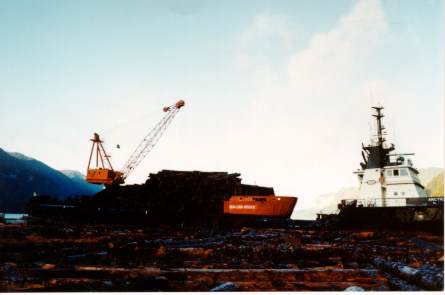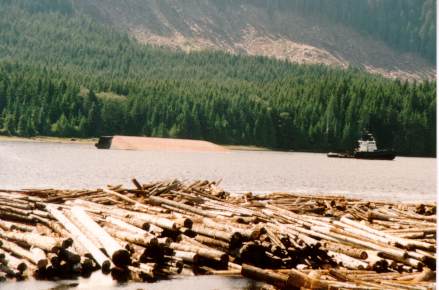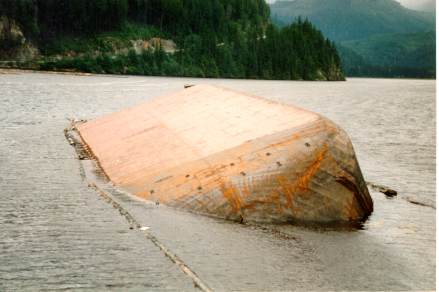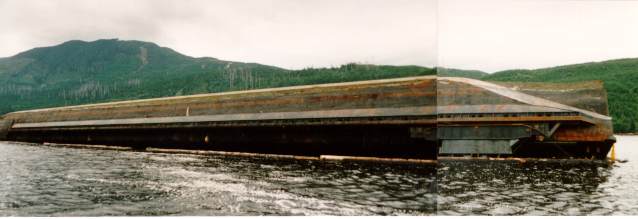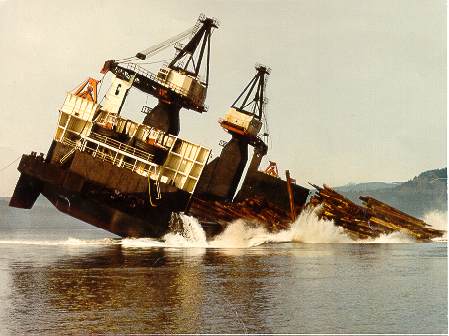Capsizing and subsequent sinking
Self-dumping Log Barge "SEA-LINK RIGGER"
Neroutsos Inlet, British Columbia
The Transportation Safety Board of Canada (TSB) investigated this occurrence for the purpose of advancing transportation safety. It is not the function of the Board to assign fault or determine civil or criminal liability. This report is not created for use in the context of legal, disciplinary or other proceedings. See Ownership and use of content. Masculine pronouns and position titles may be used to signify all genders to comply with the Canadian Transportation Accident Investigation and Safety Board Act (S.C. 1989, c. 3).
Summary
On 06 August 1995, the self-dumping log barge "SEA-LINK RIGGER" capsized during the unloading operation. When the load of logs would not dump, preparations were begun to bring the barge back to the upright and unload by crane. The load then started to dump, but the barge was not ejected from under the load and was rolled over onto its beam ends and capsized. Two crew members from the towing tug were on board the barge; the deck-hand was rescued from the water, but the mate had to escape from a pump-room of the overturned barge. The barge was declared a total loss after it sank in deep water during subsequent salvage attempts.
The Board determined that the "SEA-LINK RIGGER" capsized when, in a ballasted condition, it did not separate from a slow-dumping load of high-specific-gravity logs and the dynamics of the dumping operation rolled the barge past its beam ends. During the capsizing, a crew member from the tug "ARCTIC HOOPER" became trapped in a pump-room of the overturned barge because personnel were required to proceed below decks to control ballasting operations.
Ce rapport est également disponible en français.
1.0 Factual Information
1.1 Particulars of the Vessels
| Name | "SEA-LINK RIGGER" | "ARCTIC HOOPER" |
|---|---|---|
| Official number | 320217 | 368382 |
| IMO Number | None | 7601786 |
| Port of registry | Vancouver, B.C.Footnote 1 | Edmonton, Alta |
| Flag | Canada | Canada |
| Type | Self-dumping log barge | Tug |
| Gross TonsFootnote 2 | 3,906.78 | 394 |
| Length | 105.16 m | 33.53 m |
| Breadth | 19.54 m | 10.83 m |
| Depth | 5.76 m | 3.947 m |
| Draught | F: 4.11 m A: 4.72 m (P) 4.57 m (S) |
F: 3.35 m A: 4.26 m |
| Cargo | 7,400 tons of pulp logs | None |
| Crew (at the time of the occurrence) | 2 (from the "ARCTIC HOOPER") | 5 |
| Built | 1963, Victoria, B.C. | 1976, North Vancouver, B.C. |
| Propulsion | None | Twin-screw, 2,600 BHP |
| Owners | Sea-Link Marine Services, New Westminster, B.C. |
Union Tug and Barge Ltd., New Westminster, B.C. |
1.1.1 Description of the Vessels
The "SEA-LINK RIGGER" is a self-loading, self-dumping log barge, with a raised forecastle, soft-nosed bow, double-chined bilge and raked stern. For loading the logs, the barge is fitted with a travelling crane, mounted on rails fixed to sponsons welded on the sides of the barge. The crane base forms the after cargo stop. The hull is sub-divided into 15 watertight compartments by longitudinal and transverse bulkheads. Abaft the forepeak tank, the centre and starboard compartments are numbered 1 to 5, with no double-bottoms. The No. 1 centre compartment is the forward pump-room, the No. 5 centre is the after pump-room, and the remainder are void or ballast tanks. The port side is divided into two tipping tanks, one forward and one aft, with double-bottoms below.
The self-dumping function of the barge requires a clean deck, with no protrusions, and there are no air vents, manhole covers or sounding pipes in way of the deck area on which the logs are loaded. The tanks on the "SEA-LINK RIGGER" are vented through pipes which are led to the forecastle deck and to abaft the after cargo stop. These vents are manually opened and closed. Tanks are accessed internally from the pump-rooms and do not have manholes on the deck. None of the tanks have sounding pipes or gauges. The pumping arrangements for the tipping and double-bottom tanks are controlled from the pump-rooms and include a high-volume, low-pressure air blower to expel water from the tanks.
The "ARCTIC HOOPER" is a twin-screw coastal tug. The wheel-house has an open layout, with wide windows giving an unobstructed view in every direction. There are four conning positions in the wheel-house, one on the centre line forward, one on each side forward, and one aft facing the vessel's stern.
1.2 History of the Voyage
The barge "SEA-LINK RIGGER", in the tow of the tug "ARCTIC HOOPER", arrived at Port Alice in Neroutsos Inlet, Vancouver Island, B.C., at 0730Footnote 3 on 06 August 1995 after an uneventful, fair weather, sea passage from Iceberg Bay at the mouth of the Nass River, B.C., where the barge had been loaded with a mixture of hemlock and balsam pulp logs. The tug crew and the head loader were all aware that the high-specific-gravity, low-centre-of-gravity load would likely be difficult to dump, requiring a large angle of heel in the dumping operation.
On arrival, as part of the normal routine, a deck-hand was temporarily put onto the barge to flood the forepeak tank and bring the barge to an even keel from its seagoing stern trim after which he returned to the tug. Two small assist tugs, the "MAHATA 2" and the "WESTERN 6", were used to position the barge next to the dump grounds. The mate and a deck-hand from the "ARCTIC HOOPER" were transferred to the barge for the dumping operation. The deck-hand was at the forward end of the barge, where the "ARCTIC HOOPER" was standing by, and the mate was aft, equipped with a portable very high frequency (VHF) radio. The vents for the tipping and double-bottom tanks on deck were opened. Both men went down into their respective pump-rooms to open the valves to flood the forward and after tipping tanks. They then returned on deck for the load dump and, at 0823, the mate reported by radio that the valves were open.
After the barge had heeled to port, to the approximately 25-degree angle normally adopted for dumping, and some 30 minutes had passed without the load moving, the tug skipper decided to flood the double-bottom tanks. He gave the necessary instructions to the mate and deck-hand, and they returned to the pump-rooms and opened the valves, coming back up on deck to ride out the load dump.
Some 50 minutes later, at about 1000, the skipper received a cellular phone call from the head loader located on shore, who wanted to know if the load had dumped or if he would have to come and unload with the crane. After this discussion, the skipper declared the load a "non-dumper" and told the mate and deck-hand to blow out the tipping and the double-bottom tanks.
The mate started the diesel engine and the blower to empty the tanks, but the vents for the tanks at the after end were now under water and the mate could not reach them. He discussed the situation with the skipper and they decided to pump out the tanks instead. The deck-hand was on the forecastle operating the forward tank vents when the mate went down into the after pump-room to set up the pump valves. As he was closing the sea suction valves, the mate heard the load start to shift and he grabbed hold of the pipes, to ride the dump. The load started to dump and the barge, instead of slipping out from under the load, rotated with it until it was on its beam ends. The roll halted momentarily, and then the barge continued to roll over and it capsized. The barge struck the bulwarks on the starboard quarter of the "ARCTIC HOOPER" and came to rest upside down and listing. The time was approximately 1020.
Three tugs and the mate were involved in radio conversations during the operation, all using VHF channel 6. Another tug, the "SEASPAN REGENT", overheard the events and called the skipper of the "ARCTIC HOOPER" to tell him that the CCGS "GORDON REID" was in the vicinity. The skipper then broadcast a Mayday call on channel 16, to which the "GORDON REID" responded and sent the fast rescue craft (FRC) "GORDON REID 1".
During the capsizing, the deck-hand, who had been on the forecastle closing air vents, felt the barge pause on its port beam ends then begin to roll back to starboard, before rolling past its beam ends again and continuing on to capsize. He jumped into the water, and some part of the barge subsequently struck his hand which he was holding on top of his head. He was pushed under water by the blow, and when he surfaced, he was disoriented. The tug's other deck-hand and the chief engineer had to shout to get him to swim in the direction of the lifebuoy they had thrown him. He reached the lifebuoy and was pulled on board the tug, where he was rushed to the shower, to warm up.
The mate was in the after pump-room during the capsizing, but his grip on the pipes saved him from serious injury. With the barge capsized, the diesel engine stopped and the battery lights came on, so the mate could take stock of his surroundings. Air trapped in the pump-room was plentiful, and he took a moment to compose himself and locate the exits. He made his way into the generator room, now below the pump-room, and found the port door onto the afterdeck. Exiting through the open door, he swam clear of the barge and was picked up by the assist tug "MAHATA 2" which took him to the "ARCTIC HOOPER", where he also showered to warm up.
After they had showered and changed, the mate and deck-hand were taken ashore by the Canadian Coast Guard, transferred to an ambulance and taken to Port McNeil Hospital for examination.
1.3 Injuries to Persons
The mate from the "ARCTIC HOOPER" suffered some bruising, and the deck-hand who was on the barge with the mate had broken bones in his hand. No one else was injured as a result of the occurrence.
1.4 Barge Operations
The Dumping Procedure
Dumping is a quick method of unloading a deck cargo of logs, but it is not a procedure that has been perfected to the point where it is a fully controlled and predictable exercise. Simply, dumping is effected by heeling the barge by filling its integral tipping tanks and allowing the deck cargo of logs to slide off under their own weight. During this process, the forces involved result in a reaction which causes the barge to move away from the dumping logs. "As the tipping tanks fill with water ... the barge begins to assume an ever-increasing angle of heel, and ... there comes a point where the buoyancy of the barge overcomes the friction of the logs on the deck and the barge moves sideways out from under the load."Footnote 4
The rate at which the load dumps is related to the stability of the loaded barge. A high load, resulting in a higher centre of gravity for the barge, is less stable and will dump faster than a low, wide load such as was on board the "SEA-LINK RIGGER" at the time of the occurrence. Such fast dumps have the potential to cause a spectacular separation of barge and load. "On the very fastest of ... dumps ... the barges would actually leave the water and fly through the air .... This was due (in part) to the fact that there was almost no water in the tanks to act as an inertial force to counteract the buoyant forces"Footnote 5.
Loading Routine
The "SEA-LINK RIGGER" carried dozer boats on the afterdeck, and these were used to move the logs in the water. The logs would be lifted directly from the water using the rail-mounted deck crane, and the loading was carried out from forward to aft, the stowed position of the crane being at the after end of the barge.
The logs were bundled together in lifts of approximately 36 to 40 tons each, and the bundles were stowed athwartship across the deck. The lower tiers were two-bundles wide, butting together on the barge's centre line with their outer ends overhanging the sides of the barge. The upper tiers were one-bundle wide, centred on the barge centre line, to hold the lower tiers in place. Normal operational loading would aim to trim the barge somewhat less than 1 m by the stern for easier towing, with freeboards on completion of 1.98 m forward and 1.07 m aft. Loads were not lashed down after loading and remained unlashed for transit to the unloading area. On completion of loading, the crane would be secured to the tracks and locked in place, and the boom boats were stowed in their cradles on the afterdeck and lashed down for the trip.
Discharging/Dumping Routine
At the unloading area, two local assist tugs would aid in positioning the "SEA-LINK RIGGER" in the desired location and in preparing a boom made up of logs, which would be pulled around the log bundles when they had been dumped.
An assist tug would transfer the mate of the "ARCTIC HOOPER" to the stern of the barge and a deck-hand would board the barge forward from the deck of the "ARCTIC HOOPER". They would both open the tipping tank vents then go down into the forward and after pump-rooms to open the sea chest valves and the tipping tank flooding valves. They would then return to the deck, checking that air was coming from the tank air vents, to ride the barge as it dumped the load off the port side.
The mate and deck-hand would then close the air vents on the tipping tanks, and the mate would start up the blower in the after compartment, which forced the water out of the tanks through the tank flooding valves and sea chest valves. If the blower was not successful, or unavailable, the original pumping system was available to pump out the tanks.
Under typical operating conditions, the barge would assume the normal dumping list of approximately 25 ° with the tipping tanks filled. Should a load not slide off the deck (dump) with the tipping tanks full, then the double-bottom tanks, below the tipping tanks, could be flooded to increase the list by as much as an additional 20 °. This was required only occasionally.
1.5 Certification and Crew Experience
"ARCTIC HOOPER"
The "ARCTIC HOOPER" and her officers and crew were correctly certificated for the area and type of operation. The master and mate both had three or more years' experience in the operations of the barge. The deck-hand who was on the barge had only two months' seagoing experience, but he had participated in 10 previous discharge dumping operations. All the crew members were well rested, having performed routine watchkeeping duties during the passage from the Nass River.
"SEA-LINK RIGGER"
The barge was classed as unmanned and was uninspected. When it was installed at Esquimalt Drydock, the deck crane was tested for proof load and issued a test certificate by Transport Canada (TC) Marine Safety.
1.6 Barge Stability
The "SEA-LINK RIGGER", operating as an unmanned barge and not having any pressure vessels (ie. boilers) on board, was not subject to inspection by TC Marine Safety. Because the barge was not employed on international voyages, a load line was not assigned and there was no requirement to comply with any regulatory stability criteria.
1.7 Radio Communications and Control
Communication
The three tugs and the mate all used VHF radiotelephone channel 6 as the communication channel.
The deck-hand on the bow of the barge did not have a radio, instead direct oral communication was used between the deck-hand and the tug.
Control
The "SEA-LINK RIGGER" did not have a remote radio control system to operate the pumping system on the barge, and therefore, direct manual control of the valves and pumps was required. In log dumping barges of more recent construction, everything from the generator start-up to the dewatering process can be controlled remotely by radio from the tug.
1.8 Salvage Operations
The "SEA-LINK RIGGER" was inspected while capsized. The damage was repairable, and the owners determined to salvage the vessel themselves. During the inspection, an indeterminate amount of water was found in the centre void tank. Finding the point of ingress of the water was left until the barge was in drydock for repairs. It could not be determined with certainty whether the water was on board the barge at the time of the occurrence. Given the construction of the barge, it is unlikely that the water entered the barge while it was overturned, and therefore, the adverse effects of the water present in the tank may have contributed to the capsizing.
A first attempt at righting the barge ended when the barge sank. During the second attempt, the barge first rose with the bow vertical and it finally sank in deep water. Salvage was then abandoned and the barge declared a total loss.
1.9 Damage to the "ARCTIC HOOPER"
The tug suffered minor damage to bulwarks and fenders on the starboard quarter.
1.10 Pollution
At the time of the capsizing, the barge had an estimated 2,200 litres of diesel fuel and 900 litres of hydraulic oil on board. The oils dispersed, and the "GORDON REID", which was on the scene, did not have to intervene to prevent pollution.
1.11 Search and Rescue
The "GORDON REID" was in the vicinity and launched her FRC to assist with recovering the crew from the water. The FRC was on the scene within 15 minutes and took the mate and deck-hand to Port Alice for transfer to an ambulance. The "GORDON REID" followed the FRC to the scene and remained until the crew members had been taken ashore.
1.12 Company Policies and Standing Orders
The company has an Operations Manual on board all of its vessels. The manual has comprehensive coverage of the responsibilities of the master, officers and crew of company vessels and instructions regarding towing, ship masters' business, safety, emergencies, pollution, and operations on the Fraser River. The manual does not cover the loading/discharging operations of the "SEA-LINK RIGGER", although it does cover operations of another tug and barge which always work in combination.
There were no "as fitted" diagrams of the pumping and flooding systems on the "SEA-LINK RIGGER" available for use by the tug's crew. There was only a written description of the valves to open and close, referring to the valves by colour and size only. Knowledge was generally passed on orally from one crew to the next with, in some cases, sketches of the system made by crew members for their own use.
The company, in general, offers active support to the crews of its vessels and takes a direct interest in the day-to-day operations of the fleet.
2.0 Analysis
2.1 Separation During the Dumping Procedure
Although crew members from the tug were required to board the "SEA-LINK RIGGER" to handle the ballasting during the cargo discharging operation, the barge was classed as unmanned, and as such, was not required by regulation to have a stability book for the guidance of those operating the equipment. Consequently, a precise analysis of the stability characteristics of the loaded barge at the time of the capsizing is not possible, and stability calculations cannot be made to determine accurately the cause of the capsizing.
However, separation of the barge from the log cargo at the time of the dumping operation is at its most forceful during the fast dump of a barge with a high, relatively unstable load and little ballast water on board. The "SEA-LINK RIGGER" was carrying a low, stable load and had taken additional ballast water in the double-bottoms in an attempt to bring about the dumping of the cargo. When the load of logs dumped, the barge did not separate from the cargo and was rolled beyond its beam ends and capsized.
2.2 Tank Flooding and Dewatering System (Pumps and Blowers)
The valves for flooding and pumping out the tipping and double-bottom tanks were located in the two pump-rooms. They were manually operated in the pump-rooms, with neither extended spindles nor remote actuation to permit their operation from the deck of the barge, or by radio from the wheel-house of the tug. This required the crew to go below decks into the pump-rooms to operate the tank and sea chest valves before the tipping and double-bottom tanks could be flooded. In this particular instance, the crew had to go into the pump-rooms to operate the double-bottom tank valves while the barge was already at its normal dump angle. This resulted in the mate becoming trapped in the after pump-room when the load dumped and the barge capsized.
The air vents for the tipping and double-bottom tanks did not have automatic shut-off valves which would have eliminated the need for the crew to manually close the valves prior to blowing out the tanks.
3.0 Findings
3.1 Findings
- The "SEA-LINK RIGGER" was loaded with logs having a high specific gravity.
- The low, stable load did not dump when the barge was heeled with the tipping tanks filled.
- The barge's double-bottom tanks were also filled to increase the heel.
- When the logs did not initially dump with the double-bottoms filled, preparations were begun to discharge by crane.
- The system for flooding the tipping and double-bottom tanks required the crew to go below decks on the barge to operate valves.
- The barge did not separate from the load when the logs dumped and it was rolled beyond its beam ends and capsized.
- The mate had to enter the after pump-room, inside the barge's hull, to start the pumping out operation, and he became trapped when the barge capsized.
- The air vent pipe valves were not automatic sealing types and required manual operation prior to blowing out the tanks.
- There were no "as fitted" diagrams of the piping/pumping systems on the barge or tug for use by the tug's crew during unloading or ballasting.
- The instructions contained in the company Operations Manual are not specific to the loading/discharging operations of the "SEA-LINK RIGGER".
3.2 Causes
The "SEA-LINK RIGGER" capsized when, in a ballasted condition, it did not separate from a slow-dumping load of high-specific-gravity logs and the dynamics of the dumping operation rolled the barge past its beam ends. During the capsizing, a crew member from the tug "ARCTIC HOOPER" became trapped in a pump-room of the overturned barge because personnel were required to proceed below decks to control ballasting operations.
4.0 Safety Action
The Board has no marine safety recommendation to issue at this time.
This report concludes the Transportation Safety Board's investigation into this occurrence. Consequently, the Board, consisting of Chairperson Benoît Bouchard and members Maurice Harquail, Charles Simpson and W.A. Tadros, authorized the release of this report on .
Appendices
Appendix A - Photographs
Appendix B - Glossary
- A
- aft
- Alta
- Alberta
- B.C.
- British Columbia
- BHP
- brake horsepower
- CCGS
- Canadian Coast Guard Ship
- chine
- The line of intersection between the sides and the bottom of a flat or V-bottom hull.
- dozer boat
- A small high-powered steel boat used to push logs around in the booming area for assembly into log booms or for loading onto the deck of a barge.
- F
- forward
- FRC
- fast rescue craft
- IMO
- International Maritime Organization
- m
- metre
- (P)
- port
- PDT
- Pacific daylight time
- (S)
- starboard
- SI
- International System (of units)
- stability
- A vessel's ability to remain upright.
- TC
- Transport Canada
- TSB
- Transportation Safety Board of Canada
- UTC
- Coordinated Universal Time
- VHF
- very high frequency
